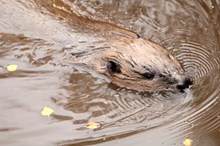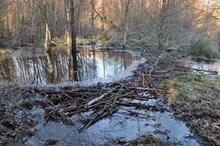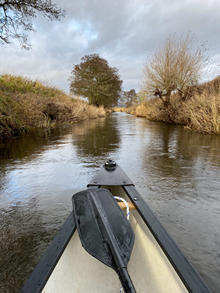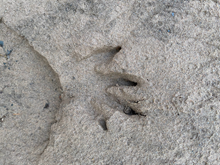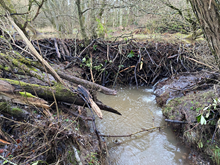17 August, 2021
Conservation success as beaver numbers double in Scotland
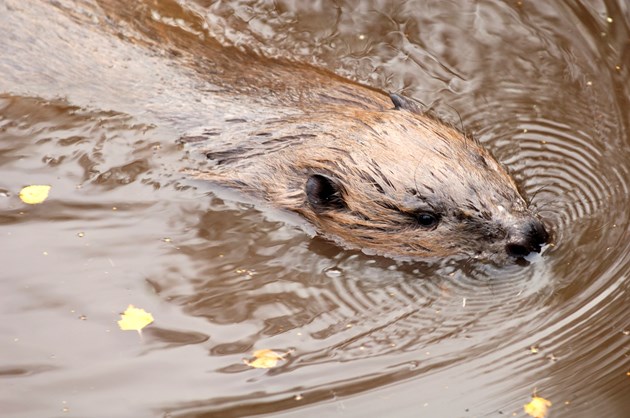
The number of beavers has more than doubled in Scotland in the last three years to around 1000 animals, according to a NatureScot survey published today (10 August).
The new population survey has not only found that beaver numbers have increased, but that the population is in a rapid expansion phase as beavers spread out from Tayside, with territory numbers also more than doubling to 251. That population now ranges from Glen Isla to Dundee and Stirling, Forfar to Crianlarich, and is likely to expand into Loch Lomond in the future.
Robbie Kernahan, Director of Sustainable Growth, said:
“Wildlife is declining in Scotland so this extensive survey, which reveals an increasing beaver population, is great news for nature in Scotland. Beavers play a vital role in creating and restoring wetlands where other species can thrive, reducing downstream flooding and improving water quality. We also hope that many people in Scotland will enjoy spotting these sometimes elusive but fascinating animals, as they become more common.”
The survey, carried out last winter, is the largest, most comprehensive and authoritative survey of beaver numbers and their range ever conducted in Britain. It gathered detailed and up-to-date information on the locations of active beaver territories, as well as assessing the health and spread of the overall population, to help inform future beaver work.
NatureScot worked with Scotland’s foremost beaver specialist, Roisin Campbell-Palmer, and experts at the University of Exeter to conduct the survey. This is the first survey conducted since beavers gained protected status as European Protected Species in Scotland in 2019 and investigated areas where beaver sightings had been reported but not confirmed.
Dr Alan Puttock, from the University of Exeter, said:
“This survey, the biggest undertaken in Britain, combined extensive field surveys and analysis to map the spatial distribution and territory dynamics of beavers across Tayside and surrounding areas. Developing this methodology in what is currently Britain’s largest wild population helps provide robust and replicable means by which to study beaver populations nationally.”
In the last survey in 2017, approximately 1,300 km of river and loch shore were surveyed. The new survey covered an even larger area, as beavers have been sighted as far afield as Loch Lomond to the west and Fife to the south east. For the 2020-2021 survey, experienced beaver surveyors searched for signs of beavers on foot and by canoe across the area, finding 13,204 confirmed signs such as burrows, dams, lodges, scent mounds, canal digging, and tree and crop feeding.
Dr Roisin Campbell-Palmer, the report lead author, said:
“Beavers are recognised as ecosystem engineers with important biodiversity benefits, though some impacts can be challenging alongside certain land-use practices. This survey will hopefully provide valuable information to land managers and policy makers seeking to maximise the benefits and minimise the conflicts associated with the return of beavers to our rivers.”
The 2020 Beaver Management Report was also published today. It outlines the range of practical mitigation measures undertaken by NatureScot and land managers last year to reduce the negative impacts of beaver activity, such as burrowing and dam building on agricultural land. It reveals that 68 active mitigation projects (such as tree protection and installing flow devices in beaver dams) were progressed. To prevent serious damage to agriculture, under species control licences reported to NatureScot, 31 beavers were trapped and moved to licensed, enclosed reintroduction projects in England, 56 beaver dams were removed, and 115 beavers lethally controlled.
These numbers are consistent with 2019, when over nine months, 15 beavers were trapped and moved to Knapdale or trial reintroduction projects in England, and 87 beavers were shot by trained and accredited controllers. This covered the period from 1 May, 2019, when beavers were granted European Protected Species (EPS) status by the Scottish Government, to the end of 2019.
Since EPS protection, lethal control is now regulated by licence, ensuring that the beaver population continues to grow and expand, while allowing impacts to be managed on particularly susceptible and important agricultural land. Most beavers benefit nature and cause no issues with landowners. However, in small number of cases, particularly on agricultural land, there can be negative impacts.
Robbie added:
“Beavers are nature’s supreme water engineers, but we know they may cause severe problems in some areas, particularly for crops on prime agricultural land and for important infrastructure like road drains or railway lines. This is reflected in the number of cases where mitigation measures were needed, such as fencing and flow devices or dam removal, as well as in the number of beavers which had to be trapped and moved or controlled under licence this past year.”
Over the last two years since beavers became a protected species, a team of NatureScot staff, aided by a specialist advisor, has given advice, support and on-the-ground assistance to land managers to install mitigation where beavers have created conflict with land management.
To read the full 2020-21 survey, see www.nature.scot/doc/naturescot-research-report-1274-survey-tayside-area-beaver-population-2020-2021
To read the Beaver Management Report, see www.nature.scot/doc/beaver-management-report-2020
Contact information
- Name
- NatureScot Media
- Telephone
- 0131 316 2655
- media@nature.scot
Notes to editors
The Beaver Tayside Survey is the third survey of beavers in the region. The first was conducted in 2012 and the second in 2017/18. The second survey identified 114 active beaver territories with an estimated 433 beavers, an increase from the 39 territories and 146 beavers estimated in 2012. The 2020/21 survey estimated there were 251 territories and an estimated population in the range of 954 individuals (mean range of 602 to 1381 individuals), with the report authors noting that this figure excludes kits born in 2021.
The 2020 Beaver Management Report draws on the new survey report on the conservation status of beavers in Scotland. These findings provide an up-to-date reference point for the range actions carried out under the beaver Management Framework in 2020. This includes an update on progress and future plans of the Beaver Mitigation Scheme, and summarises, analyses and reviews beaver species licensing.
Beavers and their dams are managed in countries around the world; one of the only drawbacks of these amazing natural engineers is that they can quite quickly and easily, for example, block a ditch or a culvert and cause flooding. As a result, beavers are legally protected in Scotland, but some management is allowed under species licence. Some of the well documented and most serious issues have occurred on the most productive areas of agricultural land in Scotland. Due to their generally being well-drained, low-lying and flat, these areas are often vulnerable to beaver burrowing and dam building.
NatureScot is continuing to work on mitigation measures as an alternative to lethal licenced control. In the 2020, the Beaver Mitigation Scheme provided advice and support for 68 cases, including installing flow devices, tree protection work, and exclusion fencing to protect agricultural land, infrastructure and property. Further mitigation trials are planned relating to water-gates and bank protection. Demand for advice remains high with good engagement and mitigation proving to be successful. Co-operation is key to mitigation and management work and is informed by the Scottish Beaver Forum, a group of partners representing conservation, farming, fisheries, and other interests, and chaired by NatureScot.
There were 17 new beaver species licences issued in 2020, including six new licences which allowed lethal control, in addition to the 45 issued in 2019. There was a notable shift in the types of licences last year from those solely intended to prevent serious damage to agriculture with five licences issued on public safety grounds (to prevent damage to infrastructure) and one issued for forestry; and five licences related to mitigation projects. The geographic spread of licences reflects the increased range of beavers; however, the focus of lethal control licences remains in areas of prime agricultural land in the Isla, Tay and Earn sub-catchments.
NatureScot is Scotland's nature agency. We work to enhance our natural environment in Scotland and inspire everyone to care more about it. Our priority is a nature-rich future for Scotland and an effective response to the climate emergency. For more information, visit our website at www.nature.scot or follow us on X at https://x.com/NatureScot
’S e NatureScot buidheann nàdair na h-Alba. Bidh sinn a’ neartachadh àrainneachd na h-Alba agus a’ brosnachadh dhaoine gu barrachd suim a chur ann an nàdar. Tha e mar phrìomhachas againn gum bi nàdar na h-Alba beairteach agus gun dèilig sinn gu h-èifeachdach le èiginn na gnàth-shìde. Tha an tuilleadh fiosrachaidh aig www.nature.scot no air X aig https://x.com/NatureScot

